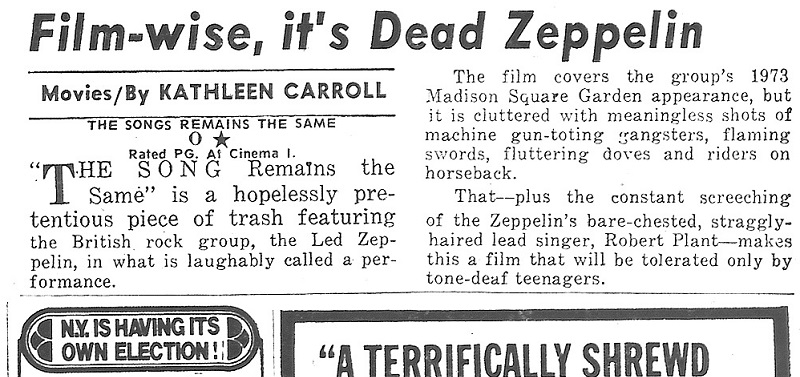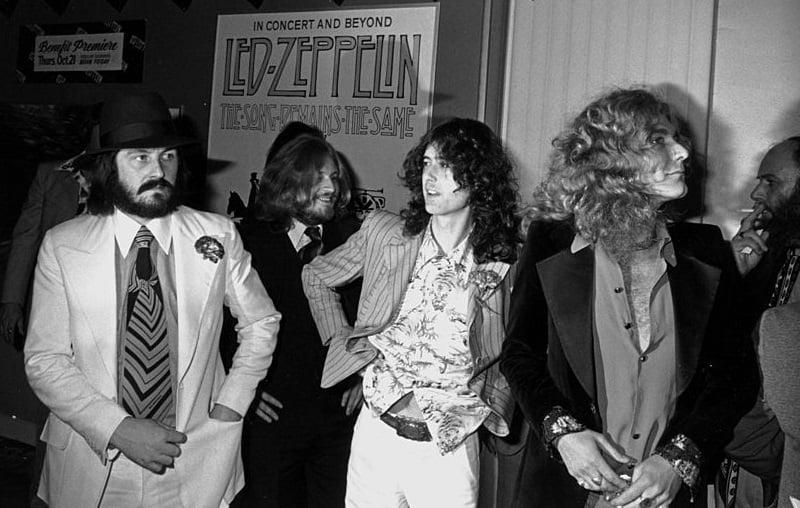Why Led Zeppelin’s ‘Song Remains the Same’ Movie Got Torched by Critics
If you like bands that don’t sit still and repeat themselves, Led Zeppelin would have been on your radar in the 1970s. That came through on the first albums. After its thrashing 1969 debut and follow-up, Zep made sure to highlight the group’s acoustic side on Led Zeppelin III (1970).
On Houses of the Holy (1973), tracks like “The Rain Song” and “No Quarter” showed Zeppelin still searching (and quite a distance from “Heartbreaker” and “How Many More Times”). And by Physical Graffiti Zep had embraced Eastern sounds with its masterpiece, “Kashmir.”
Considering each record went platinum, Zeppelin’s loyal fans made it clear they would stick with the group wherever Page might take it. However, Zep’s searching became an issue when the band released its 1976 film, The Song Remains the Same.
Working with three-year-old concert footage and showcasing what a New York Times reviewer called “pseudodreams,” Zep’s movie took a beating from critics. And the band members didn’t rate it much higher.
Critics considered Zep’s film self-indulgent at best and ‘trash’ at worst

When Led Zeppelin first had the idea to record footage for a concert film and/or documentary, a crew hustled into action to catch the end of the band’s grueling 1973 tour of America. By that time, Page and the rest of the band weren’t delivering their finest performances.
As a result, the crew had trouble getting acceptable live takes to include in the movie. (Some performances had to be pieced together from multiple concerts at Madison Square Garden.) Then came the fantasy sequences for each band member and manager Peter Grant.
These episodes likely became parodies before the shoot ended. And when the finished product hit theaters in late ’76, reviewers trashed the effort. In the New York Daily News, a critic called it “a hopelessly pretentious piece of trash.”
Over in Rolling Stone, Dave Marsh called the movie “a tribute to Led Zeppelin’s rapaciousness and inconsideration.” In the Times, Richard Eder said Plant’s signature posturing with his microphone looked “like a sheep trying to seduce a telephone pole.”
Even Led Zeppelin had soured on the film by the time of its release

While Page and Zep really took offense to bad reviews (see: Led Zeppelin III), none of the band members thought highly enough of The Song Remains the Same to take it personally. In Hammer of the Gods, Stephen Davis recounted Page writing off the concert footage’s “howling mistakes.”
Davis also described John Paul Jones tiring of the film crew, who on one occasion asked Zep’s bass player to wear the same shirt multiple nights on stage. (The filmmakers were desperately hoping for continuity they never got.)
As usual, Led Zeppelin’s fans ignored the reviews and made multiple pilgrimages to theaters to rock to their favorite band in concert. (Davis described teenagers rising for standing ovations after John Bonham’s “Moby Dick” performances.)
And like everything else Zeppelin did, the film made money. Critics took their typical shots at the band, their fans, and the excesses of the Zep mystique. The train kept rolling anyway.
Also see: How Pete Townshend Said Led Zeppelin ‘Copied’ The Who


